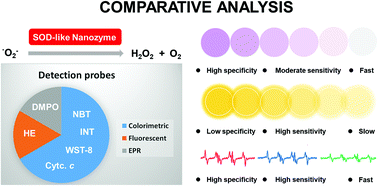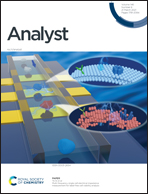In vitro measurement of superoxide dismutase-like nanozyme activity: a comparative study†
Abstract
Analyzing the SOD-like activity of nanozymes in vitro is of great importance for identifying new nanozymes and predicting their potential biological effects in vivo. However, false negative or positive results occasionally occur due to the mismatch between the detection methods and nanozymes. Here, five typical SOD-like nanozymes, including CeO2, Mn3O4, Prussian blue (PB), PCN222-Mn, and Pt NPs, have been used to evaluate the sensitivity and accuracy of several commonly used in vitro detection methods. By systematically analyzing the detection results, several precautions have been taken. (1) The hydroethidine (HE) probe could be disturbed by the nanozyme with oxidative ability. (2) The nitro blue tetrazolium (NBT) probe has a moderate sensitivity due to the poor water solubility of its reduced product. (3) The water-soluble tetrazolium salt (WST)-8 probe has a higher sensitivity than both NBT and iodonitrotetrazolium chloride (INT). (4) The detection system using the irradiation of riboflavin to produce ˙O2− might be interfered by the nanozyme with photosensibility. (5) Both the quality of DMPO and incubation time are important factors for electron paramagnetic resonance (EPR) measurement. This study will be useful for choosing more suitable in vitro detection methods of SOD-like activity for nanozymes in the future.

- This article is part of the themed collections: Analyst Recent HOT articles and Celebrating 100 years of Chemistry at Nanjing University


 Please wait while we load your content...
Please wait while we load your content...